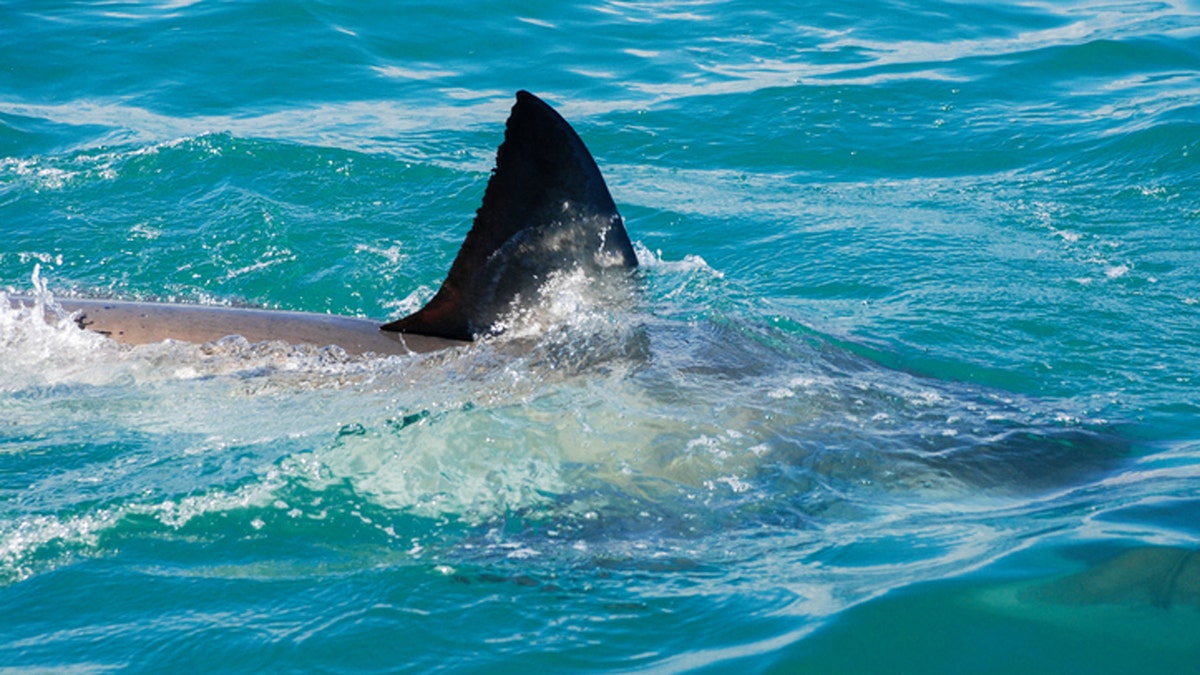
Warning signs placed along the beach to warn swimmers and surfers of recent shark sightings in San Clemente, California, last May. (REUTERS/Mike Blake, File)
Reports of shark sightings and attacks along the West Coast have popped up in the media more often lately than in years past. Horrifying accounts of legs and arms being torn off by sharks have reestablished the Jaws mentality. Beaches across the country have been reporting more frequent accounts of shark sightings and attacks.

- An undated photo - of a Great White shark which can now be repelled by a electronic shark shield. An Australian firm unveiled on March 27, 2002 an electronic shark repellant unit which when attached to swimmers legs, emits an electronic field to ??? USE ONLY (Credit : REUTERS/Seachangetechnolgy) - RTXL60Q
In May, more than a dozen white sharks were spotted off the coast of California, prompting emergency officials to warn paddleboarders: "Exit the water in a calm manner." A woman at a beach in northern San Diego lost a large chunk of her leg when a shark pulled her into the water. She would not have survived had a nearby surfer not heard her screams and rescued her. The next day, a drone camera captured a great white shark less than a quarter of a mile from swimmers in that same area.
Why the increased sightings? Fox News talked to George Burgess, director of the International Shark Attack File in Florida. “White shark populations on the West Coast had declined over several decades, but indication right now is that they’re beginning to rise again ever so slowly thanks to federal and state protection of the species,” said Burgess.
In the 1970s, the Marine Mammal Protection Act provided protection for animals such as sea lions, seals, otters, dolphins and whales, many of which are important facets of a white shark’s diet. Burgess says the act is “protecting white sharks through federal regulations and essentially providing more food by protecting primary food sources.” Burgess confirmed that white sharks are indeed on an upward path in terms of population but he emphasized that it is a very slow progression. “Recovery is going to take decades, not years,” said Burgess.
BAHAMAS SHARK BITES OFF NORTH CAROLINA WOMAN'S ARM
Over the past few years, there have been a few more white sharks on both coasts, with the East Coast seeing the same fate owing to the same regulations.
For a period the white shark population was on the decline. “The fact of the matter is during that period when white sharks declined on both coasts, human population continued to rise,” said Burgess.
Now, with white sharks on the slow uptick, they are encountering people in unprecedented levels. Seals and sea lions are encountering more humans too.

The fin of a great white shark cuts through the water, Gansbaai, South Africa (Getty Images/iStockphoto)
The sharks being sighted on the coast of Southern California are primarily young white sharks, averaging six feet in length. Burgess said “young sharks are always found in Southern California, which is a nursery area for little guys. The increase in smaller guys in Southern California is almost certainly the result of increased survivorship of regulations that have been put in place bystate and federal governments.”
The increase in the number of young sharks is a visual representation of the success of the Marine Mammal Protection Act, as well as an indication of slowly rising populations. “With an increasing population you see more young animals. Before you can get old you have to be young,” said Burgess.
GREAT WHITE SHARK STUCK IN SHALLOW WATERS CAPTURED ON VIDEO
Just because there are more youngsters does not mean the population is growing quickly, though. According to Burgess, young are born in large numbers with the expectation that you will lose some to disease or other causes.
The rising shark population “indicates to us that we need to start planning strategies as to how we’re going to reduce the opportunities for the two animals to come together. As the animals with the bigger brains and the ones who don’t live in the sea,” says Burgess, “it’s incumbent upon us as humans to modify our behavior to reduce those interactions.”
Burgess makes the comparison to humans changing their behavior when it comes to crossing roads frequented by cars and suggests we do the same thing when it comes to entering the sea in an area where sea mammals and white sharks abound.
As far as the environment goes, La Nina and El Nino years alternate and create ebb and flow in the ocean. During El Nino years, the warmer climates lead to some sharks moving into Southern California that are not native to the area. During the La Nina years, the cooler climate sends more white sharks further south – towards the Southern California area. Burgess and his team is currently conducting a study to identify what effects El Nino and La Nina have on shark attacks.
